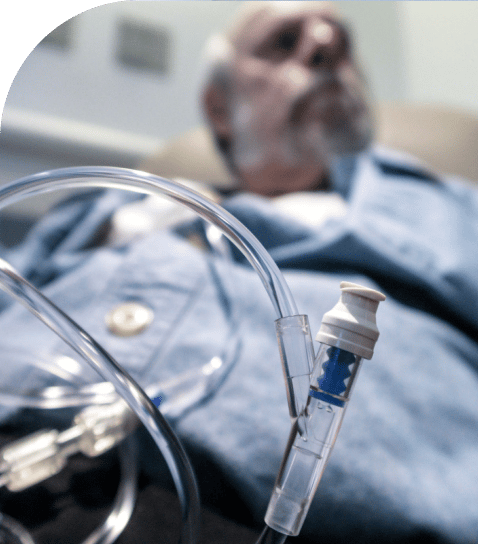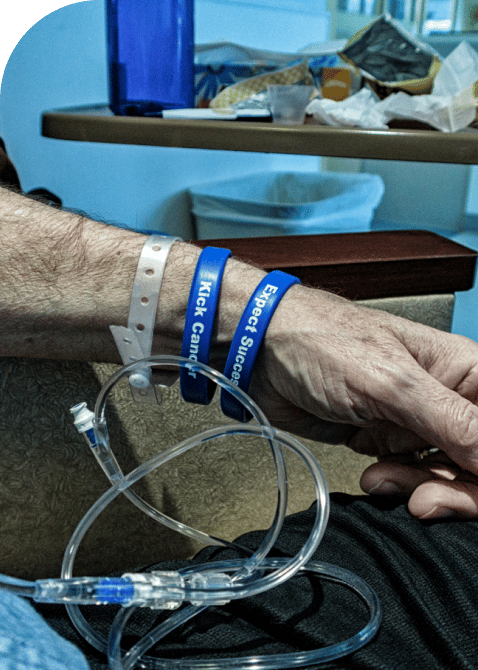Chemotherapy for Mesothelioma
Home » National Mesothelioma Law Firm » Mesothelioma Cancer » Mesothelioma Treatment » Chemotherapy for Mesothelioma
Medically Reviewed By:
Patricia Shelton, M.D.
- Page Last Updated:
- January 29, 2024
Medically Reviewed By:Patricia Shelton, M.D.
- Page Last Updated:
- January 29, 2024
Chemotherapy is a common type of mesothelioma cancer treatment. It targets and kills cancerous cells in the body. Different methods of chemotherapy can be implemented to treat mesothelioma. For example, it may be used in conjunction with surgery or as part of a palliative care plan.
Chemotherapy Agents Used for Mesothelioma
Many different chemotherapy agents are available, and different ones are used for different types of cancers. For mesothelioma—whether it’s pleural, peritoneal, or a rarer type like pericardial or testicular—the most commonly used chemotherapy regimen is pemetrexed, sometimes known by the brand name Alimta, combined with a platinum-based agent, such as cisplatin or carboplatin.
Since a 2003 clinical trial demonstrated a significant benefit to using pemetrexed along with cisplatin in patients with malignant pleural mesothelioma, this combination has been the standard chemotherapy regimen used in all types of mesothelioma. No other chemotherapy regimen has demonstrated a survival benefit in mesothelioma patients. Cisplatin is usually preferred, but for those who experience significant side effects, carboplatin can be used instead.
Pemetrexed works by blocking enzymes needed for DNA replication. Without these enzymes, cancer cells are not able to divide. Platinum chemotherapy agents like cisplatin and carboplatin work by reacting with and damaging the DNA inside cancer cells. This damage ultimately leads to the death of the cell.
Cancer cells can sometimes develop resistance to particular chemotherapy agents. Using more than one chemotherapy agent simultaneously helps to overcome this problem. When two different drugs are being used, a particular cancer cell must become resistant to both to evade the treatment. Although using two drugs rather than one does help to reduce the likelihood of resistance, it doesn’t prevent it completely, and it’s still possible for a cancer to become resistant to treatment with multi-agent chemotherapy.
A 2016 study showed that, in those patients who experienced a clinical benefit from chemotherapy, overall survival improved from 6.5 months to 16.8 months. However, not all patients responded to the treatment. The likelihood of a response varied from 45 to 63 percent, depending on the cell type of the cancer.
In most cases, chemotherapy is given in cycles. The patient comes to a cancer clinic to receive an infusion of the medications. It takes a few hours to receive a chemotherapy infusion. The body is then given time to recover before the next infusion is given. Mesothelioma patients commonly receive two to four cycles of chemotherapy spaced about three weeks apart. However, your treatment team may recommend a different protocol based on your specific situation.
Chemotherapy Drug Shortage
As of early 2023, the world is facing a shortage of cisplatin and carboplatin, leaving patients in the difficult position of choosing between omitting these important mesothelioma drugs from their treatment regimens or accepting treatments that cause more severe side effects.
The shortage has become so dire that the Food and Drug Administration is allowing unapproved cisplatin imports from China while manufacturers struggle to meet the demand. According to industry experts, the shortage may continue until the end of the year.
Ask your doctor how these shortages may impact your treatment, including the risks and benefits associated with each option. If your doctor is affiliated with a mesothelioma treatment center, you may be able to participate in a clinical trial, which could increase your treatment options.
Methods of Chemotherapy for Mesothelioma
While pemetrexed plus cisplatin or carboplatin are the standard chemotherapy drugs used in mesothelioma patients, there are several different ways that these medications may be used. These include various ways of combining chemotherapy with other treatments, as well as using chemotherapy on its own as the primary treatment modality. Different patients will benefit from different methods of treatment; your oncologist will discuss your treatment plan with you, including what they recommend in your specific case and why.
Adjuvant Chemotherapy
Adjuvant chemotherapy is given after surgery. The goal is to target any cancer cells that surgery may have left behind.
Adjuvant chemotherapy is sometimes referred to as induction chemotherapy. Technically, this is incorrect; induction chemotherapy actually refers to chemotherapy that’s given before radiation therapy, while adjuvant chemotherapy refers to chemotherapy that’s given before surgery. However, even some cancer researchers use the term “induction chemotherapy” to refer to chemotherapy given before surgery, so you may encounter this term in discussions of your medical care.
True adjuvant chemotherapy is given within three months after surgery. However, some oncologists recommend waiting to give chemotherapy after surgery until there is recurrence of the cancer. This is because there’s only one chemotherapy regimen that’s proven to be effective, and if it’s used as adjuvant chemotherapy, then there will be few additional therapeutic options left when the disease recurs. In addition, the surgical procedures used for mesothelioma are very invasive, and patients may not be healthy enough to receive chemotherapy soon after such a procedure.


Neoadjuvant Chemotherapy
Neoadjuvant chemotherapy is also used along with surgery, but in this method, the chemotherapy drugs are given before surgery rather than after. In general, the goal of this method is to shrink the tumor in order to make surgical removal easier. In some cases, neoadjuvant chemotherapy may be used on a patient whose tumor is inoperable to attempt to shrink the tumor enough that it will become possible to remove it by surgery. This is known as “downstaging.” It can also be used on a patient who already has an operable tumor; neoadjuvant chemotherapy is used to attempt to shrink it so that less tissue will need to be removed during the procedure.
Studies have shown that adjuvant and neoadjuvant chemotherapy are approximately equivalent in terms of their effectiveness. Oncologists may recommend different approaches in different patients based on factors such as the stage of the tumor and the patient’s overall medical condition.
Intraoperative Chemotherapy
Another way for chemotherapy to be given is during a surgical procedure. This method allows the chemotherapy medications to be delivered directly to the areas where mesothelioma cells are present.
Doing so increases the efficacy of the treatment and helps to reduce side effects by minimizing exposure of the rest of the body to the chemotherapy drugs. The medications are warmed before being infused in order to cause surface blood vessels to dilate and improve the ability of the chemotherapy to penetrate into the tissues.

For peritoneal mesothelioma, intraoperative chemotherapy has been part of the standard of care for years. This method is known as HIPEC or hyperthermic intraperitoneal chemotherapy. It’s used during a surgical procedure known as cytoreductive surgery, or CRS, which involves the surgeon removing as much cancer tissue as possible from the abdomen. After the removal of tumor tissue is complete, a warmed solution of chemotherapy drugs is infused into the abdominal cavity. It’s left in place for a period of time and then washed out. This method is widely considered the gold standard of treatment for peritoneal mesothelioma, and five-year survival rates have been reported to be as high as 44 percent.
More recently, surgeons have begun using a similar method for pleural mesothelioma. The method is known as HITHOC or hyperthermic intrathoracic chemotherapy. This is used during surgery to remove the cancer, which may be either extrapleural pneumonectomy (EPP) or pleurectomy/decortication (P/D). After the removal of tissue, a warmed solution of chemotherapy drugs is infused into the thoracic cavity. This is left in place for a period of time and then washed out. The available research shows that adding HITHOC to surgery extends survival by a few months, although more studies are needed to clarify how effective this treatment is.
Standalone Chemotherapy
These include patients in a more advanced stage, those who have a sarcomatoid cell type and those whose age and/or overall medical condition would not allow them to tolerate surgery.
When chemotherapy is not effective, the American Society of Clinical Oncology recommends that patients be encouraged to enroll in a clinical trial. This is because there are no effective second-line chemotherapy options available. If first-line chemotherapy has failed, then an experimental treatment may offer patients the best chance to extend life. It’s important to recognize that there are trade-offs to participating in a clinical trial; if this is an option that you’re interested in, you should discuss it with your treatment team to learn more about the potential risks and benefits of participation.
Palliative Chemotherapy for Mesothelioma
While chemotherapy can be used for treating mesothelioma in order to eliminate as much of the cancer as possible, it can also be used as part of a palliative care plan. Palliative care is a form of cancer treatment that focuses on quality of life rather than length of life.
In palliative care, chemotherapy may be used to shrink particular tumors that are causing significant symptoms. For example, in a peritoneal mesothelioma patient, a particular tumor may be causing discomfort due to a blockage of the intestine. Chemotherapy can be used to attempt to shrink this tumor and relieve the symptoms. In this case, the goal is not to eliminate the cancer cells, but to make the patient more comfortable.
In palliative care, the risks of side effects from the chemotherapy must be weighed against the potential benefits of relieving symptoms that the cancer is causing. The ultimate goal is to improve the patient’s overall comfort, and chemotherapy may not be the best way to do so in all cases.

By submitting this form, you agree to our terms & conditions. Please read full disclaimer here.



